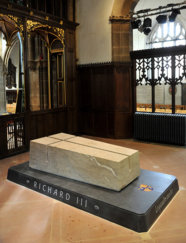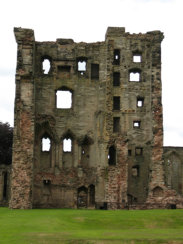Bow Bridge, Leicester
Richard led his troops out of Leicester to Bosworth over Bow Bridge and his body was carried back over it after the battle. The present bridge dates from 1863 and bears Richard's arms and motto in the centre.Key Ricardian Places in Leicestershire
Leicester Castle
The first castle was built c1068 and was of a motte and bailey type (pictured). Only the yard and hall have survived.





Leicester Guildhall
In Richard's time the Guildhall was used by the Corpus Christi Guild for meetings and provided accommodation for the Guild's Chantry Priests.Leicester Great Hall
The original hall dates back to the 12th century with the yard in front.St Mary de Castro Church
Founded in 1107, it was the chapel for the castle and was where Henry VI and Richard Duke of York were knighted in 1426.

© Richard III Society - Leicestershire Branch
Richard III Society






Leicester Cathedral
Originally built as St Martin’s parish church in the 11th century and extended in the 14th and 15th centuries. It became a cathedral in 1927 and now houses the tomb of King Richard III. Also in the cathedral are Jacqui Binns' magnificent pall and the crown, which was commissioned by John Ashdown-Hill and used in the re-interment. Tom Denny's stained glass window depicting scenes from Richard's life spills light on the tomb and the two banners donated by the society, which stand either side of the tomb. The statue of Richard III was presented by the Richard III Society in 1980 and originally stood in the Castle Gardens. It was moved to its present location prior to the reinterment in 2015.



Remains of St Mary of the
Annunciation Church
This was where Richard's body was displayed. All that remains of the church are two arches that have been re- erected in the basement of the De Montfort University's Hawthorn building.Leicester Trinity Hospital
All that is left is its chapel and a few stone arches.Plaque in Greyfriars Street
This was presented by the Richard III Society in 1990 and is located on the wall of a former bank. It was unveiled by HRH the Duke of Gloucester, patron of the society, and records that Richard was originally buried at the nearby church of the Greyfriars.



Leicester magazine gateway
The main entrance into the 'Newarke' dates from 1410. Local legend has is that Richard passed through this gate on his last visit to Leicester.Leicester Travelodge
Not a medieval building at all, but is on the site of the Blue Boar Inn where legend has it that Richard spent the night before riding out to Bosworth.Leicester turret gateway
Built c1423, it separated the castle and Newarke areas. Richard's body may have passed through the gateway on its way to the Church of the Annunciation.



Richard III Visitor Centre, Leicester
The King Richard III Visitor Centre is housed in the former Alderman Newton’s School, located right next to the spot where the king’s remains were found. The former school was built partly on the site of the former Grey Friars Church and incorporates the gravesite of the long-lost last plantagenet king of England. It is also situated directly opposite Leicester Cathedral. Leicester City Council bought the building in November 2012 and it has since been transformed into a state-of-the art visitor centre.Leicester Tudor Gatehouse
The gatehouse dates from the mid-15th century and was originally known as the Turret Gatehouse.



Ashby de la Zouch Castle
The manor was granted to William Lord Hastings in 1464 and he was granted a licence to fortify it in 1474. The Hastings Tower still remains although most of the castle is in ruins following a siege in the Civil War.King Dick’s Well
The cairn, near the Bosworth Battlefield Visitor Centre, was erected in 1813. Richard was said to have drunk from this well before the battle.King Dick’s Bed
The famous 'King Dick's Bed', reputed to be a bed belonging to Richard, is on display at Donington le Heath Manor House near Coalville. However, it is now known to be largely Jacobean with a medieval base.



Bosworth Battlefield, nr
Sutton Cheney
A must for Ricardians. There are lots of smaller places of interest to see around this area and regular guided walks are carried out from the site. A re-enactment of the battle is held every August.Sutton Cheney Church
Has marks on one of its windows where Richard's soldiers allegedly sharpened their swords before the battle.Kirby Muxloe Castle
A moated, brick-built fortified manor house, begun by William Lord Hastings in 1480 but never completed.
Leicestershire Branch



















